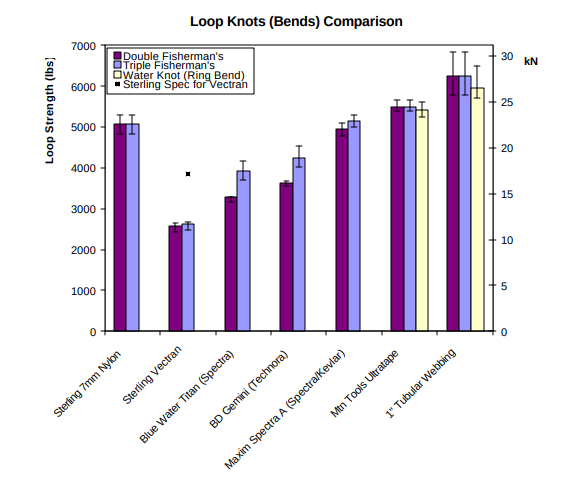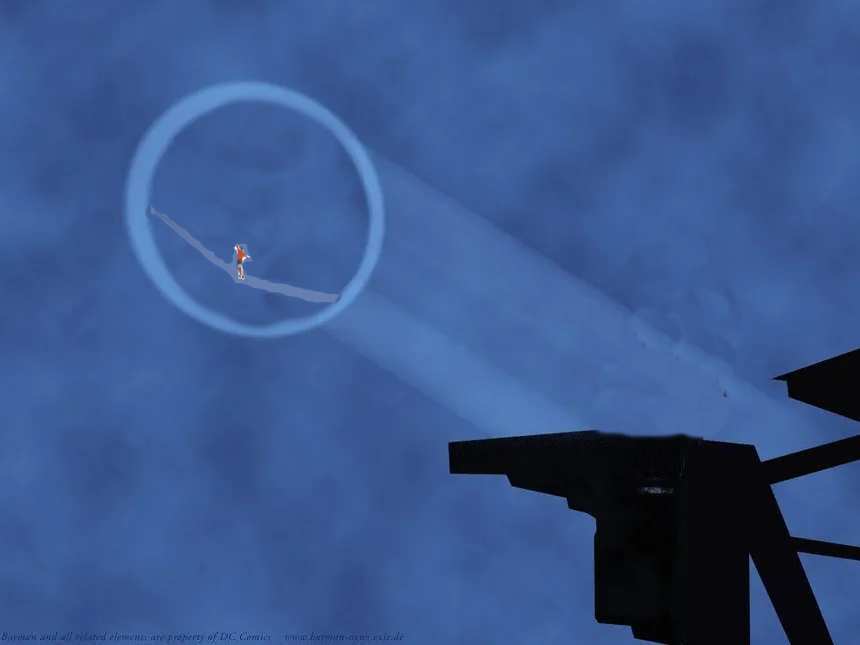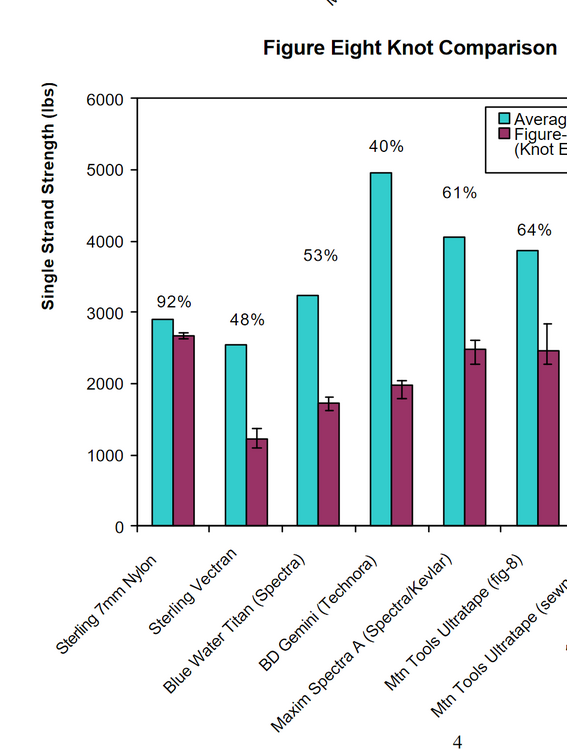Why Doesn't The Double Fisherman's Bend Seem To Reduce Knot Strength In Real World Testing?
|
|
If you google how much a double fisherman's reduces strength you get about 30-35%. When How Not 2 tested this they used cord with 9.8 kN MBS which if you double and subtract 30% we would expect a result around 13.7 kN, but they got 19.3, which if I can math right (debatable) is a reduction of 1.5%. Sterling 7mm has an MBS of 12.3 kN which if we do the same calculation gives an expected outcome of ~ 17.2 kN, but in this test they got this result: Or about 22.2 kN. That's about a 10.8% reduction. What's going on here? |
|
|
Pure conjecture here…the nature of a fisherman’s knot (single, double, whatever) is quite different from most other joining knots. These are essentially stopper knots that are conjoined so that each side or end prevents the other from escaping. The knot maintains a connection due to the fact that each stopper knot prevents the escape of its opposite because a simple knot dramatically increases the diameter of the rope. A more typical joining knot or bend relies on the friction generated by the force applied when stressing the knot—sheet bend, carrick knot, EDK, etc. That’s my intuitive explanation. No doubt I’ve misused some of the physics terms, and I’d love to see a better informed and technical explanation. Cool question! |
|
|
It's because the minimum breaking strength is just that... the MINIMUM load that the manufacturer rates the material to break at. Just like carabiners and other hardware, the manufacturer typically chooses a lower number than their average break test numbers to account for outliers and minor defects in workmanship. When derating material on a percentage basis we typically estimate based on the maximum that a knot will derate/ weaken the material, rather than the average or minimum. One of the reasons this is done is because a knot will weaken materials more or less based on the particular material, diameter, etc. For instance knots in thinner material MIGHT weaken the material than a thicker material. A more slippery high tech material like dyneema, cuts through itself or slips more easily in certain knots as compared to nylon webbing or nylon cord. TLDR: The material is actually stronger than the manufacturer rated MBS |
|
|
DrRockso RRG wrote: In this video the 7mm Mammut cord was rated to 13 kN and broke at 13.96. Let's play with those numbers. Let's say How Not 2's 9.8 kN cord would actually break a full kN higher at 10.8. Double that is 21.6, times .7 is 15.12, which is still pretty far off from the 19 it got. I guess I'd really like to see testing where this friction drum setup was applied to a piece of 7mm accessory cord and we got an actual breaking strength and then the loop with the double fisherman's was applied and we could get concrete data on how much it's reducing it. Would be cool to see the real world reduction in other bends as well. Yo Ryan, possible video idea? |
|
|
Maybe friction at the carabiners puts more load on the side w/o the knot (because the side with the knot stretches more). So you get full strength from the side w/o the knot. This could turn a 30% reduction into a 15% reduction. The rest is probably the cord being stronger than labeled like Dr Rockso said. |
|
|
Serge S wrote: How do we test your one side is full strength hypothesis? Would love to see that investigated somehow. What if you had knots on both sides to see if that's weaker? Edit to add: I am lighting the Jenks signal. This is not a drill. |
|
|
From that same pdf figure 8s are 92% efficient. This has nothing to do with fisherman's knots, loops, or conservative MBS's. Their combination of cord and test setup just makes knots look good. |
|
|
Wild speculation- the additional wraps of a double fishermans knot act to constrict the taught, linear, load bearing section of cord exiting the knot. This constriction lessens the pulling force on the the rest of the knot. Less pull means larger radius' once weighted, which means more retained strength. Ricky the chart you posted seems to show that a triple fisherman's is stronger than a double. Since a double f and a triple f are so similar in shape, the minimum radius in the knot should be similar and perhaps it's just more wraps means more friction inside the knot on the load bearing section. |
|
|
Look at knots for extremely slippery fishing line. They use a shit ton of wraps to get friction to progressively transfer the load. |
|
|
Ryan already did this with a bunch of cords, using a diverter (full strength ish), then 8-to-8, then in a loop with double fisherman's knot. https://m.youtube.com/watch?v=u8HqVNuE5ko Data: https://hownot2.com/blogs/big-wall-bible/pc-vs-vtx https://hownot2.com/collections/accessory-cord (at the bottom) |
|
|
K Go wrote: Rad, thank you! It looks like the loop strength is less than double the 8 to 8 strength, suggesting the double fisherman's is weaker than the F8. Interesting stuff! |
|
|
Ricky, A strong case can be made that all tests on knots that seek to probe a knots MBS yield point are largely irrelevant. What matters most in life critical applications is security, stability, jam resistance, utility, (+ a few other aspects which I wont go into). It is a well established proposition that 'a' knot will reduce the MBS of the rope/cord that it is tied in (not many would disagree with this - hard to make a case against this proposition). If someone publishes knot MBS yield point test results that conflict with this proposition, the tester/author would need to back up the claim with solid evidence (extraordinary claims require extraordinary evidence). With specific regard to the Ryan Jenks video and testing, again, it comes down to how much credence you wish to place on 'his' results. You can imagine that there has been a very long list of knot testers from all around the world - all of whom have published their results. What can we glean from all of these hundreds of knot tests results? Some testers apply high levels of rigor - to try to reduce the uncertainty of their results. Some don't apply high levels of rigor (I make no comment on who does, and who doesn't). You might also imagine that if someone publishes results, the way is open for others to run their own tests, and compare results - and either confirm, refute, or modify the theory (this is how science is done - someone publishes claims, and then others check, verify or refute, or come up with a competing theory). In the realm of knots, I have to say that testers typically work and publish in isolation (some do collaborate, but it tends to be less often). Again in relation to R Jenks, how much rigor do you think he applied? (its a question, not an accusation). For example, was a baseline MBS yield point established and verified by empirical means or was the manufacturers given MBS figures assumed to be correct? (again, this is a question, not an accusation). And then results would fall somewhere on a 'bell curve' and then a concept called 'standard deviation' (eg 3 sigma, 6 sigma, etc) would also be considered? Presumably a tester should publish information on how reliable (ie level of uncertainty) the claimed results are (or not)? There are some authors/testers who have published interesting papers on the subject of knots - a notable author is Robert Chisnall (do a search for his papers), and perhaps Thomas Evans (although his papers are ageing), and a more recent paper by Jan Simon, Vladimir Dekys, P Palcek (university of Zilina) titled; "Revision of commonly used loop knots efficiencies" (I would give this paper in particular a higher 'weighting' compared to others). Another paper titled; "Topological mechanics of knots and tangles" is interesting because it employed colour changing fibres to investigate propagation of tensile force. I know many high level knot geeks who simply roll their eyes when yet another knot MBS yield test result is published - adding to the list of published knot MBS yield results. They 'roll their eyes' because it appears that many testers appear to have no other way to conceptualise knots other than by looking at MBS yield. I have to say that the 'Hard is Easy' youtuber has published some refreshingly different 'knot tests' - which examined resistance to jamming (and how knot geometry plays an important role in raising the jamming threshold). Eg; his video on the Figure 8 eye/loop knot. This is a departure from the usual MBS yield type of thinking... |
|
|
Mark Gommers wrote: Amazing. I'm going to read this comment ten times at least. I will read your recommendations. Thank you. |
|
|
Mark Gommers wrote: Great resources Mark, thanks! For others interested, the Simon et al. is at http://doi.org/10.12693/APhysPolA.138.404 and Patil et al. is available here: https://doi.org/10.1126/science.aaz0135.. The first seems to be open-access; less sure about the second. I can provide a pdf to folks with trouble getting it. |

 Continue with onX Maps
Continue with onX Maps Sign in with Facebook
Sign in with Facebook
























